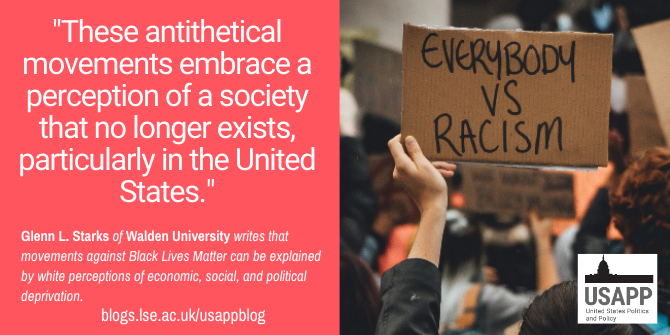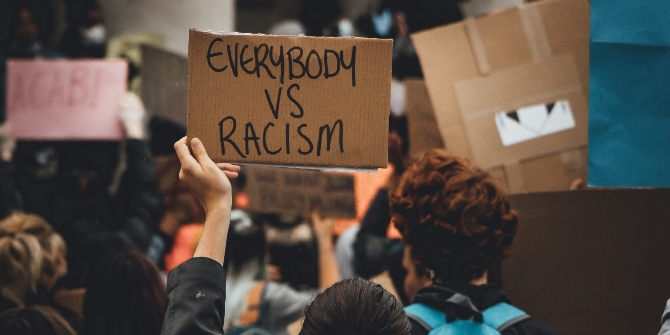 Over the past decade, the Black Lives Matter movement has brought tens of millions of people together to demand and campaign for an end to institutionalized racism in law enforcement, politics, and society. This movement has been met by opposing groups which are focused on maintaining white supremacy. Glenn L. Starks writes on how Relative Deprivation Theory can explain the rise of these opposing movements where, spurred on by right-wing politicians, many whites wrongly perceive a loss of personal, professional, and political prestige as the US moves towards a culture of greater of equality and inclusiveness.
Over the past decade, the Black Lives Matter movement has brought tens of millions of people together to demand and campaign for an end to institutionalized racism in law enforcement, politics, and society. This movement has been met by opposing groups which are focused on maintaining white supremacy. Glenn L. Starks writes on how Relative Deprivation Theory can explain the rise of these opposing movements where, spurred on by right-wing politicians, many whites wrongly perceive a loss of personal, professional, and political prestige as the US moves towards a culture of greater of equality and inclusiveness.
The Black Lives Matter (BLM) movement galvanized 15 to 26 million people worldwide to demand justice and reforms for the inequities still being faced by of Black people, but also to recognize their resiliency and contributions to society. The movement was founded in 2013 in response to the acquittal of the murderer of Trayvon Martin. Since, it has grown in response to overly aggressive police tactics that have resulted in the deaths of many more Blacks, particularly male, leading to a demand for the end of institutionalized racism in law enforcement, politics and general society that has manifested itself into policies and actions designed to subjugate Black humanity. The ideology of BLM is “combating and countering acts of violence, creating space for Black imagination and innovation, and centering Black joy, we are winning immediate improvements in our lives.” Although BLM is an ideology rather than an organization, it has been met with organized opposing movements mostly focused on maintaining the ideals of white supremacy. However, this resistance is fueled by a perceived, rather than actual, psychological gap in power and self-worth by many whites that can be explained by the Relative Deprivation Theory (RDT).
As illustrated in Figure 1, RDT holds that individuals who perceive they are economically, socially, or political deprived result to in blaming others for their perceived loss. Rather than analyzing their own educational, occupational or lifestyle choices, they focus on others to substantiate conscious misgivings over the circumstances of their own lives. Restated, to fill the gap of perceived relative deprivation, one must find a substitute or at least a psychological cork to plug the hole of perceived loss. In 1960, noted US sociologist Herbert H. Hyman postulated that a person’s self-concept of their economic, intellectual, social, and cultural achievements is measured in comparison to those that are similar (i.e., in their reference group) compared to those in other reference groups. Being part of this reference group is therefore the means in which a person derives their perception of self-value as well as even their attitudes towards others. With their shared beliefs and attitudes, these groups then use their collective power in attacking the groups they feel threatened by. In the case of BLM, white supremacist groups led the resistance to any threat to their “way of life” using such mantras as “Make America Great Again”, “All Lives Matter” and “taking back our country.”
Figure 1 – Choice of Reference Groups based on Relative Deprivation Theory

What is most troubling is that these groups were spurred on by politicians under the helm of Donald Trump, culminating with the insurrection at the US Capitol on January 6, 2021. The insurrection was inevitable given the level of hatred and violence that grew during the Trump presidency. As evidenced by the Southern Poverty Law Center, Trump’s presidency resulted in “a surging White nationalist movement that has been linked to a series of racist and antisemitic terror attacks and has coincided with an increase in hate crime.” The Republican Party’s support of these antithetical movements was not so much because they were racist or even really opposed BLM. Rather, they feared for their own political fate as they watched mayors, governors, members of the US Congress, the Vice President and the President of the United States who looked, spoke, acted and/or epitomized the inclusive majority values of America being elected to office.
Perceptions of loss and neo-racism
These antithetical movements embrace a perception of a society that no longer exists, particularly in the United States. Perceptions of a loss of perceived personal, professional, and political prestige have driven the need for fearful members to use passive and violent tactics against those they blame. Their fear of no longer being relevant in the demographic hierarchy has been used as the basis for recruiting active members and particularly passive supporters. This angry resentment is then turned into action through the use of symbolic racism, where antithetical movements use symbols of the confederacy, racial epithets, neo-Nazi imagery, an admiration of communism, and distorted patriotism as part of their rallying cries.

Photo by Arthur Edelmans on Unsplash
This breeding of a culture war or us-against-them strife are components of this new racism or neo-racism. This new classification of racism, or White privilege, in the current era began in the Western US in opposition to immigrants resettling in the 1980s and 1990s. It applies to BLM antithetical movements with two opposing sides having different perceptions on the predominant culture of the United States, one based on a country moving into an era of equality and inclusiveness versus a culture clinging to supremacy and worth based on a dominant race.
Support for White supremacist groups and other antithetical movements did not stop once Trump left office in January 2021. Republican congressional leaders continue their support of them with policies, statements, and actions in preparation for the 2022 mid-term elections. As part of this misinformation campaign, they continue to use conspiracy theories and misinformation campaigns to portray BLM supporters and anyone who supports them just as or more dangerous than White supremacist groups. Rather than focusing on the millions of peaceful supporters, attackers of the movement continue pushing a narrative of Antifa militants, the dangers many Whites face from infiltrated crime and violence, and the portrait of a Democratic Party led by pedophiles and a satanic cult. While this sounds ridiculous to the average reader, these tactics are reaching millions of disenfranchised White Americans suffering from the delusions of relative deprivation.
Addressing white privilege by changing mindsets
Relative Deprivation Theory explains antithetical movements against BLM, but also points to what must be done to combat these movements: change the mindset of those feeling deprived to foster positive versus negative aspirations that leads their selective affinity to select positive reference groups. For example, the continued support of BLM and policies enhancing hate crime penalties by Congress as well as corporate boycotts of states embracing discriminatory policies are means to exemplify central political and cultural views of the country. This also serves to change mindsets.
There must also be a continued investigation into the causes of such antithetical movements, but also directed actions among citizens, grass roots organizations, the media, corporations, and other stakeholders to hold elected officials who support such movements accountable for their part in promoting division. Antithetical movements are not just in opposition to ideologies like BLM, but also some of the most basic tenets of democracy. It is apparent what occurs when actions are not taken to seriously address the myth of White privilege. In the United States books are being banned from school libraries, hate crimes are rising, and voting rights laws are being repealed. Republican legislators at the federal, state, and local levels of governments are using the momentum of antithetical movements against BLM to achieve their ultimate goals of rewriting American history, attacking equality through a direct route of curbing democracy, and controlling the future by controlling the minds of our youth for their own personal political gain.
- This article is based on the paper, ‘Explaining Antithetical Movements to the Black Lives Matter Movement Based on Relative Deprivation Theory’, in the Journal of Black Studies.
Please read our comments policy before commenting.
Note: This article gives the views of the author, and not the position of USAPP – American Politics and Policy, nor the London School of Economics.
Shortened URL for this post: https://bit.ly/3uEvUqg
About the author
 Glenn L. Starks – Walden University
Glenn L. Starks – Walden University
Glenn L. Starks, PhD, holds a doctorate in public policy and administration from Virginia Commonwealth University’s L. Douglas Wilder School of Government and Public Affairs. Starks has over 30 years of experience working for the U.S. government and has written extensively on public administration and American politics, including two recent books on African Americans and government, African Americans and the Presidents: Politics and Policies from Washington to Trump and African Americans at Risk: Issues in Education, Health, Community, and Justice. He also has taught graduate courses in public administration and policy at several universities.




Great read. Thank you.